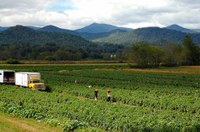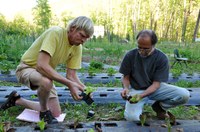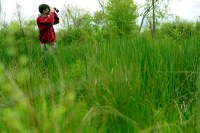Land Use
Where people meet the land
Land use is what it sounds like—the multitude of different uses to which people put different parcels of land, including such things as agriculture, forestry, urban development, and protections for fish and wildlife. Because land use is influenced by economics, demographics, social values, and natural ecosystem properties, land use information helps to reveal how our activities are both shaped by and impact ecosystems. This people-land relationship is crucial for understanding ecosystem services.
Mapping economic activities in the Appalachians—things such as agriculture, outdoor recreation, forestry, and energy development—against demographic patterns, infrastructure, conservation areas, and ecosystem types can help to reveal how communities and regional populations interact with ecosystems. Agricultural land use, for example, can have both positive and negative effects on soil and water quality, depending on particular practices. Those practices may be determined by farmers’ cultural preferences, wealth, and access to transportation infrastructure and markets. Different land uses can also influence one another in important ways. For example, outdoor recreation in the Appalachians helps drive the development of second homes, increasing both land values and forest fragmentation, which in turn affects additional recreational uses.
Managing these kinds of land use changes through various planning and conservation strategies can make the difference between promoting or impairing the capacities of landscapes to provide ecological services. Conservation and restoration efforts occur both inside and outside of official conservation areas like parks, and they can be difficult to map to particular land uses without additional information. For example, former mine sites in the Appalachians are subject to forest restoration requirements, but different reclamation practices can have different outcomes in terms of forest regrowth, water quality improvement, and the restoration of other ecological functions. Designated conservation areas help protect ecosystem services, but heavy recreational use in these places can compromise the sustainability of some services. In multi-use areas, sustainable harvests of nontimber forest products like wild ginseng may depend on managing land uses as diverse as mountain biking and energy infrastructure development, not to mention the harvesting activities themselves.
Detailed land uses can be difficult and expensive to map, and accurate data are often only available for dominant uses such as agriculture and urban areas. Nonetheless, mapping land use across large landscapes can be a key source of information about ecosystem service use and sustainability, and it has rapidly become a cornerstone for understanding regional ecological change. It is usually at its most useful when paired with additional information about specific economic activities, management practices, and so on.
 Demographics and
|

Economics and Business
|
|
References
Amichev, B. Y., J. A. Burger, and J. A. Rodrigue. 2008. Carbon sequestration by forests and soils on mined land in the Midwestern and Appalachian coalfields of the U.S. Forest Ecology and Management 256(11): 1949–1959.
Bowker, J. M., and A. Askew. 2013. Outlook for outdoor recreation in the northern United States. A technical document supporting the Northern Forest Futures Project with projections through 2060. Gen. Tech. Rep. NRS-120. USDA Forest Service, Northern Research Station: 62 pp.
Bowker, J. M., A. Askew, H. K. Cordell, and J. C. Bergstrom. 2013. Outdoor recreation, Chapter 8, 161–182. In D. N. Wear and J. G. Greis, editors, The Southern Forest Futures Project: Technical Report. Gen. Tech. Rep. SRS-178, USDA Forest Service, Southern Research Station: 542 pp.
Burcher, C., H. Valett, and E. Benfield. 2007. The land-cover cascade: relationships coupling land and water. Ecology 88:228–242.
Burcher, C. L., and E. F. Benfield. 2006. Physical and biological responses of streams to suburbanization of historically agricultural watersheds. Journal of the North American Benthological Society 25: 356–369.
Butler, B. J., and D. N. Wear. 2013. Forest ownership dynamics of southern forests, Chapter 6, 103–121. In D. N. Wear and J. G. Greis, editors, The Southern Forest Futures Project: Technical Report. Gen. Tech. Rep. SRS-178, USDA Forest Service, Southern Research Station: 542 pp.
Chamberlain, J. L. 2006. Conserving the Appalachian medicinal plant industry, 5–16. In Proceedings, Fourth Annual Symposium on Appalachian Opportunities - Medicinal and Aromatic Plants, Beckley, WV, 16–17 September 2005.
Chamberlain, J. L., S. Prisley, and M. McGuffin. 2013. Understanding the relationships between American ginseng harvest and hardwood forests inventory and timber harvest to improve co-management of the forests of eastern United States. Journal of Sustainable Forestry 32(6): 605–624.
Daniel, W. M., D. M. Infante, R. M. Hughes, Y.-P. Tsang, P. C. Esselman, D. Wieferich, K. Herreman, A. R. Cooper, L. Wang, and W. W. Taylor. 2015. Characterizing coal and mineral mines as a regional source of stress to stream fish assemblages. Ecological Indicators 50: 50–61.
Ford, C. R., S. H. Laseter, W. T. Swank, and J. M. Vose. 2011. Can forest management be used to sustain water-based ecosystem services in the face of climate change? Ecological Applications 21(6): 2049–2067.
Hanson, C., L. Yonavjak, C. Clarke, S. Minnemeyer, L. Boisrobert, A. Leach, and K. Schleeweis. 2010. Southern Forests For the Future. World Resources Institute, Washington, D.C.: 73 pp.
Jackson, L. E., B. Rashleigh, and M. E. McDonald. 2012. Economic value of stream degradation across the central Appalachians. Journal of Regional Analysis and Policy 42(3): 188–197.
Keyser, T., J. Malone, C. Cotton, and J. Lewis. 2014. Outlook for Appalachian-Cumberland forests: a subregional report from the Southern Forest Futures Project. General Technical Report SRS-GTR-188. USDA Forest Service, Southern Research Station: 83 pp.
Kuhman, T. R., S. M. Pearson, and M. G. Turner. 2010. Effects of land-use history and the contemporary landscape on non-native plant invasion at local and regional scales in the forest-dominated southern Appalachians. Landscape Ecology 25(9): 1433–1445.
Kuhman, T. R., S. M. Pearson, and M. G. Turner. 2011. Agricultural land-use history increases non-native plant invasion in a southern Appalachian forest a century after abandonment. Canadian Journal of Forest Research 41(5): 920–929.
Larsen, E., J. Grossman, J. Edgell, G. Hoyt, D. Osmond, and S. Hu. 2014. Soil biological properties, soil losses and corn yield in long-term organic and conventional farming systems. Soil and Tillage Research 139: 37–45.
Law, J., and K. McSweeney. 2013. Looking under the canopy: Rural smallholders and forest recovery in Appalachian Ohio. Geoforum 44: 182–192.
Lemke, D., C. J. Schweitzer, W. Tadesse, Y. Wang, and J. A. Brown. 2013. Geospatial assessment of invasive plants on reclaimed mines in Alabama. Invasive Plant Science and Management 6(3): 401–410.
Lindberg, T. T., E. S. Bernhardt, R. Bier, A. Helton, R. B. Merola, A. Vengosh, and R. T. Di Giulio. 2011. Cumulative impacts of mountaintop mining on an Appalachian watershed. Proceedings of the National Academy of Sciences108(52): 20929–20934.
Lockaby, G., C. Nagy, J. M. Vose, C. R. Ford, G. Sun, S. McNulty, P. Caldwell, E. Cohen, and J. Moore Myers. 2013. Forests and water, Chapter 13, 309–339. In D. N. Wear and J. G. Greis, editors, The Southern Forest Futures Project: Technical Report. Gen. Tech. Rep. SRS-178, USDA Forest Service, Southern Research Station: 542 pp.
Matthews, S. N., L. R. Iverson, M. P. Peters, A. M. Prasad, and S. Subburayalu. 2014. Assessing and comparing risk to climate changes among forested locations: implications for ecosystem services. Landscape Ecology 29(2): 213–228.
McTammany, M., E. Benfield, and J. Webster. 2008. Effects of agriculture on wood breakdown and microbial biofilm respiration in southern Appalachian streams. Freshwater Biology 53(4): 842–854.
Morzillo, A. T., C. R. Colocousis, D. K. Munroe, K. P. Bell, S. Martinuzzi, D. B. Van Berkel, M. J. Lechowicz, B. Rayfield, and B. McGill. 2015. “Communities in the middle”: Interactions between drivers of change and place-based characteristics in rural forest-based communities. Journal of Rural Studies 42: 79–90.
Shifley, S. R., F. X. Aguilar, N. Song, S. I. Stewart, D. J. Nowak, D. D. Gormanson, W. K. Moser, S. Wormstead, and E. J. Greenfield. 2012. Forests of the Northern United States. Gen. Tech. Rep. NRS-90, USDA Forest Service, Northern Research Station: 202 pp.
Souther, S., and J. B. McGraw. 2014. Synergistic effects of climate change and harvest on extinction risk of American ginseng. Ecological Applications 24(6): 1463–1477.
U.S. Department of Agriculture Forest Service. 2012. Future of America's Forests and Rangelands: Forest Service 2010 Resources Planning Act Assessment. Gen. Tech. Rep. WO-87. USDA Forest Service: 198 pp.
Wear, D. N., R. Huggett, R. Li, B. Perryman, and S. Liu. 2013. Forecasts of forest conditions in regions of the United States under future scenarios: a technical document supporting the Forest Service 2012 RPA Assessment. Gen. Tech. Rep. SRS-GTR-170. USDA Forest Service, Southern Research Station: 101 pp.
Wickham, J., P. B. Wood, M. C. Nicholson, W. Jenkins, D. Druckenbrod, G. W. Suter, M. P. Strager, C. Mazzarella, W. Galloway, and J. Amos. 2013. The overlooked terrestrial impacts of mountaintop mining. BioScience 63(5): 335–348.
Wickham, J. D., K. H. Riitters, T. G. Wade, M. Coan, and C. Homer. 2007. The effect of Appalachian mountaintop mining on interior forest. Landscape Ecology 22(2): 179–187.
Zipper, C., J. Burger, J. McGrath, and B. Amichev. 2007. Carbon accumulation potentials of post-SMCRA coal-mined lands, 962–980. In Proceedings of a Joint Conference of the American Society of Mining and Reclamation 24th Annual National Conference, June 2–7, 2007, Gillette, Wyoming.
Zipper, C., J. Burger, J. Skousen, P. Angel, C. Barton, V. Davis, and J. Franklin. 2011. Restoring forests and associated ecosystem services on Appalachian coal surface mines. Environmental Management 47(5): 751–765.


























